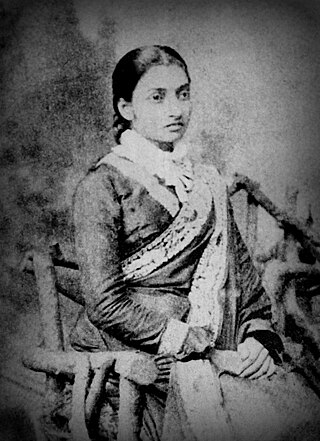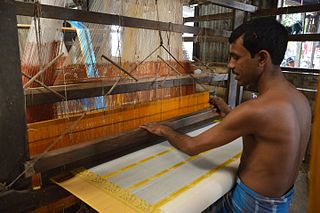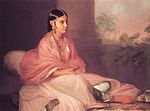
Muslin is a cotton fabric of plain weave. It is made in a wide range of weights from delicate sheers to coarse sheeting. It is commonly believed that it gets its name from the city of Mosul, Iraq.

A sari is a women's garment from the Indian subcontinent. It consists of an un-stitched stretch of woven fabric arranged over the body as a robe, with one end attached to the waist, while the other end rests over one shoulder as a stole (shawl), sometimes baring a part of the midriff. It may vary from 4.1 to 8.2 metres in length, and 60 to 120 centimetres in breadth, and is a form of ethnic wear in India, Sri Lanka, Nepal, Bangladesh, Pakistan. There are various names and styles of sari manufacture and draping, the most common being the Nivi style. The sari is worn with a fitted bodice also called a choli and a petticoat called ghagra, parkar, or ul-pavadai. It remains fashionable in the Indian subcontinent today.
Ikat is a dyeing technique from Southeast Asia used to pattern textiles that employs resist dyeing on the yarns prior to dyeing and weaving the fabric. In Southeast Asia, where it is the most widespread, ikat weaving traditions can be divided into two general groups of related traditions. The first is found among Daic-speaking peoples. The second, larger group is found among the Austronesian peoples and spread via the Austronesian expansion to as far as Madagascar. It is most prominently associated with the textile traditions of Indonesia in modern times, from where the term ikat originates. Similar unrelated dyeing and weaving techniques that developed independently are also present in other regions of the world, including India, Central Asia, Japan, Africa, and the Americas.

Jamdani is a fine muslin textile produced for centuries in South Rupshi of Narayanganj district in Bangladesh on the bank of Shitalakhwa river.

Paithani is a variety of sari, named after the Paithan town in Chattrapati Sabhaji Nagar district from state of Maharashtra in India where the sari was first made by hand. Present day Yeola town in Nashik, Maharashtra is the largest manufacturer of Paithani.

Phulia is a census town in the Santipur CD block of the Ranaghat subdivision in the Nadia district in the Indian state of West Bengal. It is birthplace of 'Adi kavi' of Bengal Krittibas Ojha.

Silk In India, about 97% of the raw mulberry silk is produced in the Indian states of Karnataka, Andhra Pradesh, Tamil Nadu and West Bengal. Mysore and North Bangalore, the upcoming site of a US$20 million "Silk City", contribute to a majority of silk production. Another emerging silk producer is Tamil Nadu in the place in where mulberry cultivation is concentrated in Salem, Erode and Dharmapuri districts. Hyderabad, Andhra Pradesh and Gobichettipalayam, Tamil Nadu were the first locations to have automated silk reeling units.

Nakshi kantha, a type of embroidered quilt, is a centuries-old Bengali art tradition of the Bengal region, notable in Bangladesh and Indian states of West Bengal, Tripura and part of Assam. The basic materials used are thread and old cloth. Nakshi kanthas are made throughout Bangladesh, primarily in the areas of Mymensingh, Jamalpur, Bogra, Rajshahi, Faridpur, Jessore, and Chittagong.

A Sambalpuri sari is a traditional handwoven bandha (ikat) sari wherein the warp and the weft are tie-dyed before weaving. It is produced in the Sambalpur, Balangir, Bargarh, Boudh and Sonepur districts of Odisha, India. The sari is a traditional female garment in the Indian subcontinent consisting of a strip of unstitched cloth ranging from four to nine meters in length that is draped over the body in various styles.

Baluchari Sari is a type of sari, a garment worn by women in the Indian states of West Bengal, Tripura and Assam and the country of Bangladesh. This particular type of sari originated in West Bengal and is known for depictions of mythological scenes on the anchal of the sari. It used to be produced in Murshidabad but presently Bishnupur and its surrounding areas of West Bengal are the only place where authentic Baluchari saris are produced. It takes approximately one week to produce one such sari. In 2011, the Baluchari Sari was granted the status of Geographical Indication for West Bengal in India.

The boteh, is an almond or pine cone-shaped motif in ornament with a sharp-curved upper end. Though of Persian origin, it is very common and called buta in India, Azerbaijan, Turkey and other countries of the Near East. Via Kashmir shawls it spread to Europe at least in 19th century, where patterns using it are known since 1960s as paisleys, as Paisley, Renfrewshire in Scotland was a major centre imitating them.
Uppada Jamdani saree is a silk sari style woven in Uppada of East Godavari district in the Indian state of Andhra Pradesh. It was registered as one of the geographical indication from Andhra Pradesh by Geographical Indications of Goods Act, 1999. Uppada Jamdani saris are known for their light weight.

The history of the textile arts of Bangladesh dates back to the 1st century AD. According to the archaeological excavations, Bangladesh was once famous for its artistic textile production throughout the world. Over the years, several types of textiles evolved in the country, mostly by the indigenous handloom manufacturers.

Handloom saris are a traditional textile art of Bangladesh and India. The production of handloom saris is important for economic development in rural India.
The handloom industry in Tangail is one of the oldest cottage industries in West Bengal. This traditional saree is produced in Tangail district and is named after the place.
Murshidabad silk is produced in Murshidabad district of West Bengal. This silk is produced from mulberry silkworms reared on mulberry trees. Murshidabad silk is known for its premium quality. This silk is very fine, light weight and easy to drape. Two famous saris produced from Murshidabad silk are Baluchari and Gorood.

Shantipuri sari is a traditional handwoven cotton sari of West Bengal. It is produced in the Shantipur city and surrounding area of Nadia district, West Bengal. Shantipuri handloom sari is famous for the novelty of designs, hand spinning method with extra weft, different color patterns and the thin finesse of the fabric. The fine Shantipuri sari is a highly demanded commodity all over the world. Shantipuri Sari got geographical indications tag in 2009.

Tangail saree is a traditional handwoven saree (Sari) of West Bengal. It is produced in Purba Bardhaman & Nadia districts of West Bengal. These handlooms are famous for the novelty of saree designs, hand-woven booties, use of natural fibers in the weave and saree fineness of the fabric. In 2024, Tangail Saree was recognized as a Registered Geographical indication under the title Tangail Saree of Bengal and Banglar Tangail Saree in Bengali language.

Tangail saree is a traditional handwoven saree of Bangladesh. It originated in the Tangail district of the country. A completely different kind of saree is produced in the Purba Bardhaman and Nadia districts of West Bengal. It is a simplified Jamdani textile which is a hybrid of Shantipuri saree with saree desighns and handloom techniques of Tangail. At one level, it is a gross simplification of the famed Jamdani technique. This is completely different from the Tangail sari of Bangladesh.

Shantipur Handloom Industry, also known Shantipur Handloom Cluster, is a handloom weaving industry in Nadia district of West Bengal. It is one of the foremost handloom centers of India. This handloom industry is world famous for the production of cotton Sari (saree). The two main centers of this industrial zone are Shantipur and Phulia. Shantipur has an old reputation for cotton sarees, known as Shantipuri sarees, and Phulia is well known for Tangail-Jamdani sarees.





















